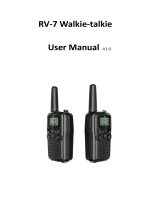
4 Topcom Twintalker 9100
Topcom Twintalker 9100
• Turn your radio OFF as soon as interference is taking place with medical equipment.
• Do not replace batteries in a potentially explosive atmosphere. Contact sparking may
occur while installing or removing batteries and cause an explosion.
• Turn your communicator off when in any area with a potentially explosive atmosphere.
Sparks in such areas could cause an explosion or fire resulting in bodily injury or even
death.
• Never throw batteries in fire as they may explode.
4.4 Poisoning danger
• Keep batteries away from small children
4.5 Legal
• In some countries it is prohibited to use your PMR while driving a vehicle. In this case
leave the road before using the device.
• Turn your unit OFF when on board an aircraft when instructed to do so. Any use of the
unit must be in accordance with airline regulations or crew instructions.
• Turn your unit OFF in any facilities where posted notices instruct you to do so. Hospitals
or health care facilities may be using equipment that is sensitive to external RF energy.
• Replacing or modifying the antenna may affect the PMR radio specifications and violate
the CE regulations. Unauthorised antennas could also damage the radio.
4.6 Notes
• Do not touch the antenna while transmitting, it could affect the range.
• Remove the battery if the device is not going to be used for a long period.
5 Cleaning and maintenance
• To clean the unit, wipe with a soft cloth dampened with water. Don’t use a cleaner or
solvents on the unit; they can damage the case and leak inside, causing permanent
damage.
• Battery contacts may be wiped with a dry lint-free cloth.
• If the unit gets wet, turn it off and remove the batteries immediately. Dry the battery
compartment with a soft cloth to minimize potential water damage. Leave the cover off
the battery compartment overnight or until completely dry. Do not use the unit until
completely dry.
Areas with potentially explosive atmospheres are often, but not
always, clearly marked. They include fuelling areas such as
below deck on boats, fuel or chemical transfer or storage
facilities; areas where the air contains chemicals or particles,
such as grain, dust or metal powders; and any other area where
you would normally be advised to turn off your vehicle engine.


















